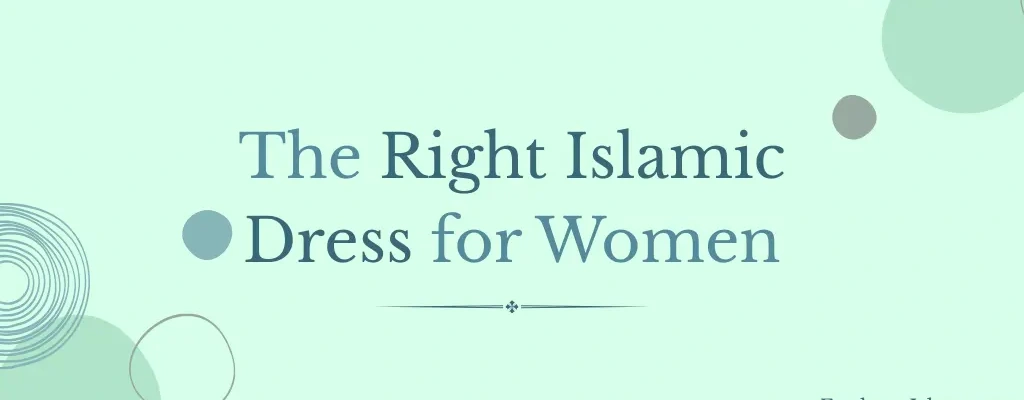Islamic dress for women isn’t just about covering up; it’s about having modesty on the inside and out. Islamic dress helps women interact respectfully with others and focus on their spiritual growth instead of following trends or seeking approval from others.
The Quran outlines the purpose of proper attire. In Surah Al-Ahzab (33:59), Allah Almighty says:
“O Prophet, tell your wives and your daughters and the women of the believers to bring down over themselves [part] of their outer garments. That is more suitable that they will be known and not be abused. And ever is Allah Forgiving and Merciful.”
This verse, along with others and prophetic traditions (Hadith), shows that the Islamic dress code is meant to keep women safe. The right Islamic dress is about letting women be known for their faith, instead of being seen as objects or harassed.
What is the Right Islamic Dress for Women?
Let’s explore the broader concept of the right Islamic dress for women, referred to as hijab.
There is no single “right” Islamic dress garment. The “right” dress is one that adheres to the principles of covering the awrah, being loose, opaque, modest, and dignified.
Hijab is not just about a headscarf; it encompasses a complete system of modest dressing.
For a garment to be considered Islamically appropriate for women in public or in the presence of non-mahram men (men who are not close relatives), it should generally meet the following conditions:
1. The Right Islamic Dress for Women Must Cover the Entire Body
The Islamic clothing must effectively conceal the entire ‘awrah according to the scholarly opinion one follows.
The majority of scholars agree that a woman’s ‘awrah in front of non-mahram men is her entire body.
2. The Right Islamic Dress for Women Must be Loose and Non-Revealing
The Islamic clothing should be loose-fitting and not reveal the shape of the woman’s body.
The Islamic clothing should not be figure-hugging or clingy.
Skinny jeans, leggings, or any pants that are tight and form-fitting do not meet the Islamic conditions of dress because they reveal the shape of the legs and buttocks.
Asma bint Abi Bakr (may Allah be pleased with her) rejected a gift of fine, see-through garments, stating,
“If it is not transparent, it describes [the body].” [Sahih]
3. The Right Islamic Dress for Women Must be Opaque and Non-Transparent
The fabric should be thick enough and not see-through. The fabric should not reveal the skin color or body underneath.
Garments that are transparent are considered to fall under the description of “clothed but naked,” as mentioned in the Hadith narrated by Abu Hurairah (may Allah be pleased with him) from the Prophet (peace and blessings be upon him):
“There are two types of the people of Hell whom I have not seen yet: … and women who are clothed but naked…”) [Sahih Muslim 2128]
This Hadith warns against clothing that, although technically covering the body, fails to conceal it properly due to transparency.
4. The Right Islamic Dress for Women Must Not be an Adornment in Itself
The Islamic clothing should not be excessively decorative or designed to attract undue attention. You can look neat and presentable, but don’t wear anything too fancy or flashy.
This is derived from the Quranic verse:
“and not expose their adornment” [Quran 24:31].
The verse instructs women not to display their adornments, and scholars extend this to include clothing that is itself excessively adorned and attention-grabbing.
5. The Right Islamic Dress for Women Must Not be Perfumed (When Going Out)
Applying strong perfumes when going out in public is generally discouraged for women in Islam, as it can attract unwanted attention.
The Prophet (peace and blessings be upon him) said:
“Any woman who applies perfume and passes by people so that they may smell her fragrance is an adulteress”. (Sunan an-Nasa’i 5126)
6. The Right Islamic Dress for Women Should Not Resemble Men’s Clothing
The Islamic clothing for women should generally not resemble garments that are exclusively worn by men in the local culture.
This is based on the Prophet’s (peace and blessings be upon him) condemnation of gender imitation in dress. Ibn Abbas (may Allah be pleased with him) narrated:
“Allah’s Messenger ursed the women who imitate men and the men who imitate women”. [Sahih al-Bukhari 5885].
7. The Right Islamic Dress Must Not be Garments of Fame or Vanity
Islamic clothing should not be worn for the purpose of showing off, seeking fame, or displaying arrogance. Modesty is rooted in humility and sincerity.
This is supported by the Hadith narrated by Ibn Umar (may Allah be pleased with him):
“The Messenger of Allah said: ‘Whoever wears a garment of pride and vanity, Allah will clothe him, on the Day of Resurrection, in a garment of humiliation.” [Sunan Ibn Majah 3606].
Final Word
The right Islamic dress for women is far more than just clothing—it is a reflection of faith, modesty, and dignity. By following the Islamic dress code, Muslim women protect their honor, fulfill Allah’s command, and present themselves with respect and humility.
The hijab and other forms of modest clothing are not about suppressing individuality but about empowering women to be valued for their faith, character, and inner strength rather than appearance.
In essence, the Islamic dress allows women to walk with dignity, safeguard their chastity, and proudly express their identity as believers.
If you have further questions or need clarification, it’s always best to consult with knowledgeable and trustworthy sheikhs. Feel free to browse through our blog for more articles on women’s issues.

